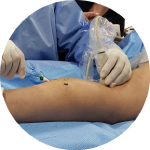
A successful sclerotherapy procedure involves many elements. Near the top of the list: management of patient expectations. Julian J. Javier, MD, FSCAI, FCCP, walked an International Vein Congress audience through Sclerotherapy: Technical Steps.
Patients often have high expectations for the procedure, he said, and it's important for them to know that they're "not going to have the legs they had when they were 15 or 16 years old." It's also important to understand that sclerotherapy will typically be done during multiple treatments.
That said, the procedure can deliver desired results.
Dr. Javier said it begins with identifying the areas of concern, including asking the patient what's bothering them the most. Equipment should be assembled and prepared before the procedure begins. Physicians should know their sclerosing agents; develop a systematic approach so they'll know which areas have already been treated; and continue working to refine technique.
The equipment involved is simple: alcohol, nonsterile gloves, 3 ml syringes, a 30-gauge ½-inch needle for spider veins, a 25- to 27-gauge butterfly needle for reticular veins, cotton balls, paper tape, compression stockings and carbon dioxide. The most common solutions used, he said, are sodium tetradecyl sulphate and polidocanol, in lower concentrations for use with spider veins than reticular veins.
Dr. Javier begins the procedure with the reticular veins, injecting close to spider clusters, and ending with spider veins. He cautioned against overtreating and recommended a three-second delay before pulling out the needle. He also briefly discussed the use of visual aids. As physicians perform these procedures more and more, he said, those visual aids won't be as necessary. "But they do help very much."
Treatment of spider veins takes a bit more skill, he said, and must be done slowly. Needles may also need to be exchanged if they become dull from multiple punctures.
While managing the patient's expectations, it's important to discuss potential complications and to have the patient sign a consent form. Complications may include staining, angiogenesis, allergic reactions and phlebitis. As for after care, that consists of placement of cotton balls and paper tape to help avoid skin issues; compression stockings for a few days up to a few weeks and a return visit in four to six weeks.
The presentation is just one of many available at VeinGlobal.com, the site for increased insight and understanding in the realm of venous disease treatment.
Recent Posts

Review of Radiofrequency Ablation Devices

Overtreatment in CVD Leads to Superficial Ablation Abuse

Ultrasound-guided Foam Sclerotherapy

Recurrent Stent Occlusion: Endovenectomy, Bypass, or Compression Only

Optimizing Deep Vein Images: The Profunda Femoris Vein

A Closer Look at Swollen Legs: Edema Differentiation

Vein Global and IVC are Evolving to Launch the Next Decade of Endovascular Innovation and Education

Phlebectomy: Technical Steps with Jose I. Almeida, MD, FACS, RPVI, RVT

The Spectrum of Vacuum-Assisted Venous Thrombectomy

Sclerotherapy: Technical Steps with Julian J. Javier, MD, FSCAI, FCCP

